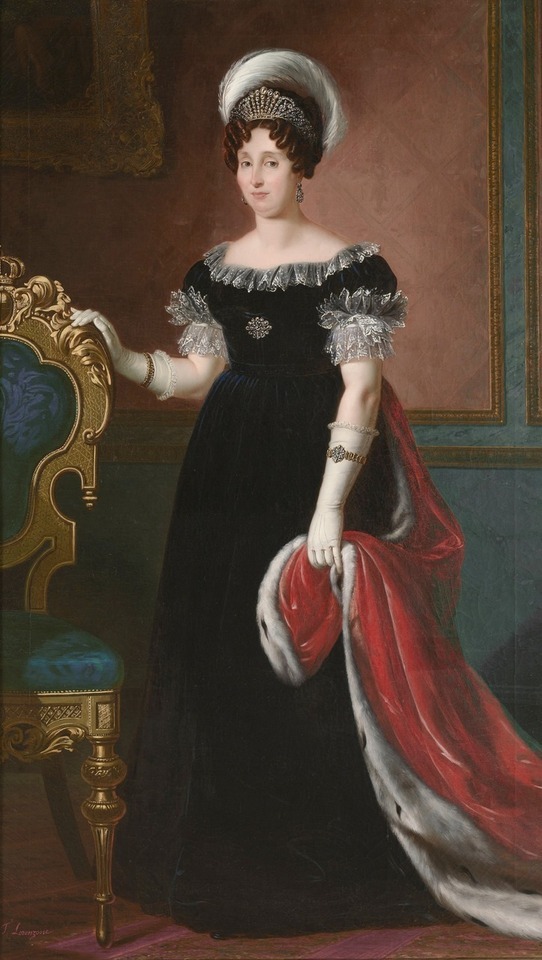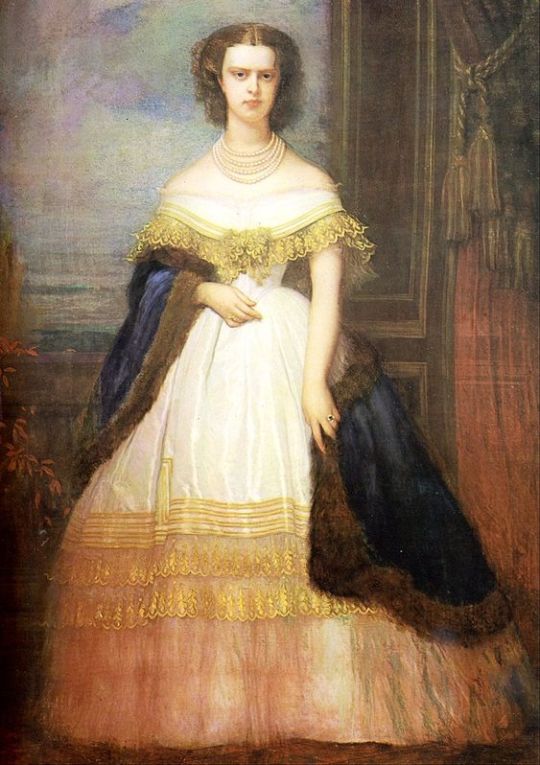#wife of victor emmanuel i of sardinia
Explore tagged Tumblr posts
Photo

Maria Theresa of Austra-Este, Queen of Sardinia (1 November 1773 - 29 March 1832)
#maria theresa of austria-este#maria theresia josefa johanna#queen of sardinia#daughter of archduke ferdinand of austria#wife of victor emmanuel i of sardinia#history#women in history#18th century#19th century#art
39 notes
·
View notes
Photo

A Royal Recluse: Princess Clotilde
Just at the time when, in consequence of the weakness and folly of the republican government, certain French Monarchists are looking to Prince Victor Napoleon Bonaparte as the possible savior of their country, the Prince, whose marriage to Princess Clementina of Belgium recently brought him before the public, was watching by the deathbed of his mother, Princess Clotilde of Savoy, who breathed her last on June 25. The story of this royal lady is a pathetic one and, apart from the interest that is attached to her as the mother of the imperial candidate to the French throne, her personal character was one of rare beauty.
She was the daughter of Victor Emmanuel II, first King of Italy, and of Adelaide, Archduchess of Austria, and was born at Turin on March 2, 1843. Her mother died in 1855, leaving five young children, of whom Clotilde was the eldest, the others being Humbert, the future King of Italy ; Amadeo, Duke of Aosta ; Maria Pia, the queen dowager of Portugal, and a son who died in childhood. The Queen of Sardinia (Victor Emmanuel had not at that time laid violent hands on the independent states of Italy) was an exemplary wife and mother, and her orphan daughters were carefully educated by the attendants whom she had placed about them.
Never was a princess more ruthlessly sacrificed to political interests than the eldest princess of Savoy. When a mere child of sixteen, Clotilde was chosen to cement the alliance between France and Sardinia, and was promised in marriage to Prince Napoleon Jerome, nephew of Napoleon I and first cousin Napoleon III, the reigning sovereign. Princess Clotilde was connected with the Bourbons, her very name was French and was given to her in memory of the French Princess Marie Clotilde, sister of Louis XVI, who married a King of Sardinia ; but allied as she was by close ties of blood to the Bourbons, she had nothing in common with the Bonapartes who occupied their place, and a more ill-assorted couple never existed than the middle-aged, violent, cynical and free-thinking Prince Napoleon and the daughter of the most ancient royal house in Europe, who traditions and surroundings were strictly conservative and religious. Their marriage took place at Turin on January 30, 1859. The bride was sixteen and the bridegroom thirty-seven. He had a handsome presence and was intelligent and well informed and well informed, but neither his private life nor his freely expressed opinions on public matters made him estimable or lovable. His attitude with regard to his cousin, the Emperor, was one of constant opposition, and it was reported that his anti-religious views led him to take part in the banquets organized by a group of free thinkers on Good Friday. Under the Second Empire the French Government was officially Catholic, and Prince Napoleon's hostile and aggressive attitude was pronounced ill-bred, if not worse. Throughout France he was distinctly unpopular.
The young bride, married to this unsympathetic nephew of the great Napoleon, probably had few illusions as to the sum of happiness that awaited her in her new home. There are still some old men living who remember her when she took possession of the Palais Royal, Prince Napoleon's Paris house.: a slight, pale girl, with fluffy, fair hair and bright eyes, not pretty but singularly attractive. Her high breeding stood her in good stead in the somewhat parvenu atmosphere of the Court of the Tuileries, she had a royal dignity all her own, and her simplicity of heart was combined with much quiet firmness. From the first she ordered her life according to the principles in which she had been educated. An early riser, even at the Palais Royal, she gave much time to prayer and to works of mercy, but her piety, says M. Emile Ollivier, a former minister of Napoleon II, “never made her tiresome or intolerant. She believed that the most useful sermon was the practice of the virtues that are taught by faith.” Her husband, although so widely apart from her, acknowledged her goodness. “Clotilde is a saint,” he sometimes said ; “if there were many like her, I believe I myself should end by becoming devout.”
When the disastrous war of 1870 brought terror and shame upon France, the Princess was in Paris. During that fatal month of August every day came news of a fresh defeat, and the revolution that was to break out on the 4th of September was already distinctly perceptible; the infuriated and terrified people made the imperial government responsible for the reverses that so keenly wounded their patriotic pride.
Princess Clotilde was alone at the Palais Royal ; her husband was with the army, her three children she sent to Switzerland, where Prince Napoleon had an estate; but she steadily refused to leave Paris while the Empress Eugénie remained at the Tuileries. There was not much personal sympathy between the two; it was Princess Clotilde's feeling of loyalty that chained her to the post danger as long as there was a semblance of imperial government in Paris.
In vain her husband wrote imperious messages bidding her join her children at Prangins; in vain her father sent the Marquis Spinela to Paris to escort her ; the Princess so yielding in everyday life, was unbending in her decision to remain at the palace as long as the lonely woman at the Tuileries was the nominal ruler of France ; she had shared the splendors of the Empire, and it went against her noble spirit to desert the Empress.
The letter this young woman, a stranger in a strange land, wrote to her father on August 25, 1870, has been quoted by the French papers. It is a right royal letter worthy of the daughter of kings:
“I am a French woman,” she says. “I cannot desert my country. When I married although so young, I knew what I was doing and if I did it, it was because I wished to do so. The interest of my husband, of my children and of my country require that I should remain here. The honor of my name, your honor, my dear father, and that of my country also demand it. Nothing will make me fail in what I believe to be my duty to the end... You know that the house of Savoy and fear have never gone together, and you would not wish that they should meet in my person.”
At last, when the Empress was driven from her palace by the mob, the Princess considered that she was free to follow, but how different was the departure of the two women!
The brilliant and beautiful sovereign, closely disguised, was only able to leave Paris owing to the assistance of her American dentist, Dr. Evans; her young cousin made her exit as a princess. In an open carriage, accompanied by her lady in waiting, she drove to the railway station in broad daylight. The excited people, awed by her courage and dignity, saluted her as she passed out of their sight, a truly royal and saintly figure.
Princess Clotilde lived for some years at Prangins, near Geneva, where she devoted herself to the education of her three children; then, when her husband was allowed to return to France, the difficulties of her married life were such that by mutual consent she retired to the Castle of Moncalieri, near Turin, with her young daughter. Here, in the home of her childhood, she spent nearly forty years. They were years of peace, largely marked by sorrow. Four times only did she emerge from her retreat, once in January 1878, when she heard that her father lay dangerously ill in Rome. She had suffered cruelly from the spoliation of the Holy See by the house of Savoy, and the remembrance of her father's part in the matter prompted her to fly to his bedside. On the way she heard that he was dead, and she sadly returned to Moncalieri. In 1891, she again started for Rome, this time to visit her husband, who lay dying at the Hotel de Russie. Those who saw the Princess during those solemn days can never forget her sweetness, earnestness and gentle patience. What passed between her and Prince Napoleon none can tell, but Cardinal Mermillod a frequent visitor to the sick room, professed himself satisfied, after two private interviews, that the dying man was fully conscious. The Princess, whose married life, it is well known, had been a via crucis, remained near him to the end, praying incessantly for the soul that probably owes its salvation to her intercession. Again in 1903 and in 1904, she left Moncalieri to visit her sister-in-law, Princess Mathilde Bonaparte, whose deathbed she attended.
Her life, as it neared the end became more and more that of a recluse. Her sons lived their own lives in Brussels and in Russia; her daughter, having married a Prince of Savoy, was near to her, and their visits, occasionally brought an element of joy into the silent castle. Last autumn, Prince Victor Napoleon's marriage to the Princess Clémentine of Belgium gladdened his mother's heart. It was celebrated at Moncalieri, and to those who attended the ceremony the most striking figure present was the slight, gray-haired lady, plainly dressed in black, whose eyes had the far-away look of those who are nearing the eternal shore. Even in the days of her youth Princess Clotilde's spirituality struck M. Emile Ollivier. It gave her, he says a singular insight into all questions that touch on right and wrong; she possessed the gifts of the true mystics, “who judge human affairs with a clearness and rectitude born of detachment.” Her chief link with the outer world during the long, silent years of old age was her love for the poor, to whom she gave royally, with a loving kindness that made her gifts more precious. Their grief was great when they heard of her death, and their prayers will follow her remains to the royal mausoleum of La Superga, near Turin, where the daughter of the Sardinian Kings sleeps with her ancestors.
America. United States, America Press, 1911.
#princess clotilde of savoy#italian royal family#bonaparte#napoleon jerome bonaparte#biography#french royal family#house of bourbon
35 notes
·
View notes
Photo

Maria Theresa of Austria-Este (1 November 1773 – 29 March 1832) was born an archduchess of Austria-Este and a princess of Modena. She was later Queen of Sardinia as wife of Victor Emmanuel I of Sardinia.
#Maria Theresa of Austria-Este#House Austria-Este#XVIII century#XIX century#people#portrait#paintings#art#arte
2 notes
·
View notes
Photo


A pair of miniatures of Victor Emmanuel I of Sardinia, and his wife, Maria Theresa of Austria-Este.
#Maria Theresa of Austria-Este#victor emmanuel i#sardinia#house of savoy#house of austria este#long live the queue
34 notes
·
View notes
Photo

Maria Christina of Savoy, Queen of the Two Sicilies (14 November 1812 - 21 January 1836)
#maria christina of savoy#maria cristina carlotta giuseppa gaetana efisia#queen of the two sicilies#daughter of victor emmanuel i of sardinia#wife of ferdinand ii of the two sicilies#history#women in history#19th century#art
7 notes
·
View notes